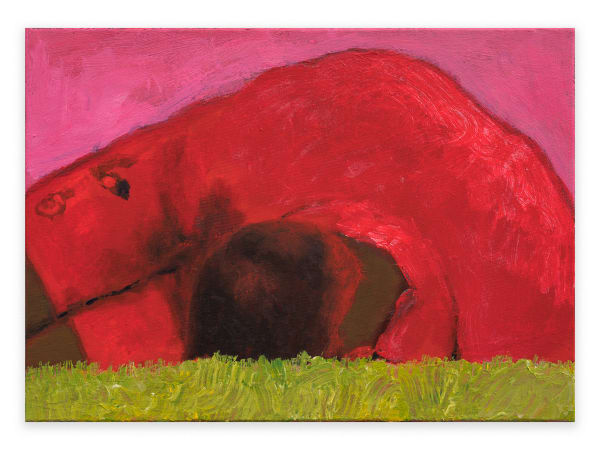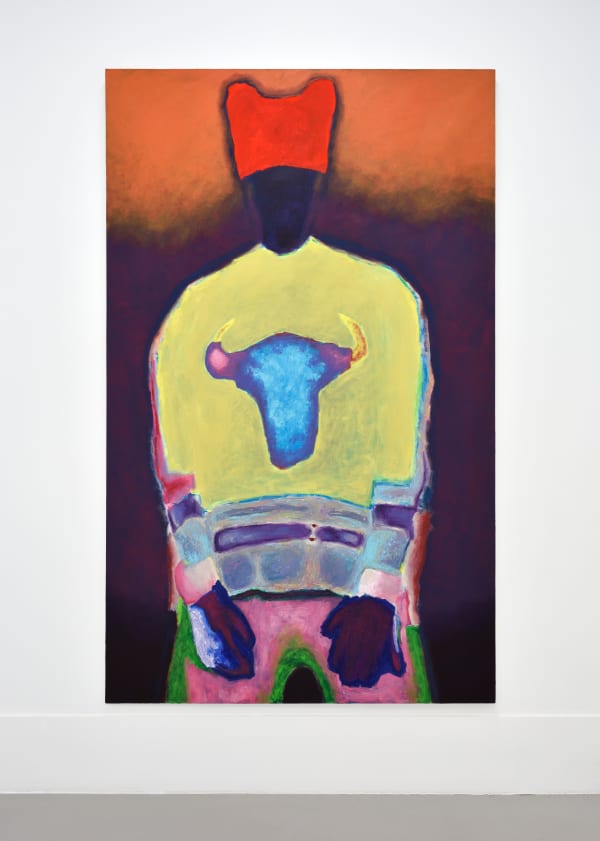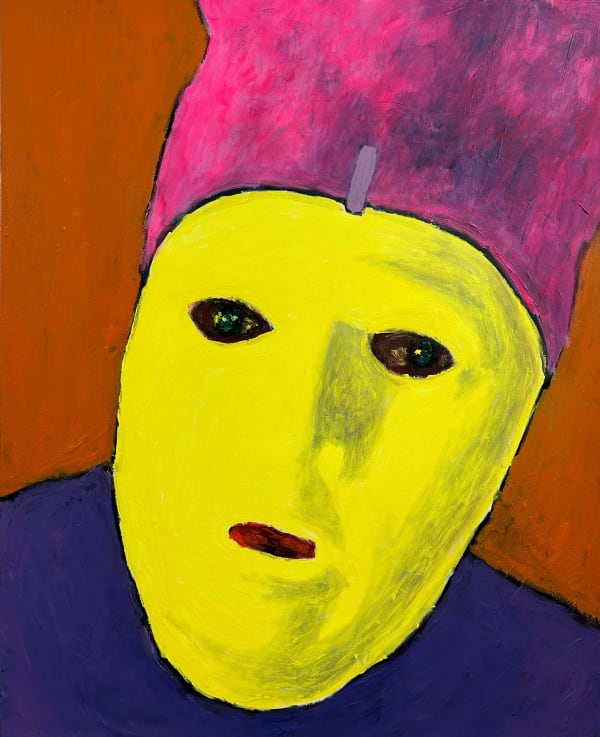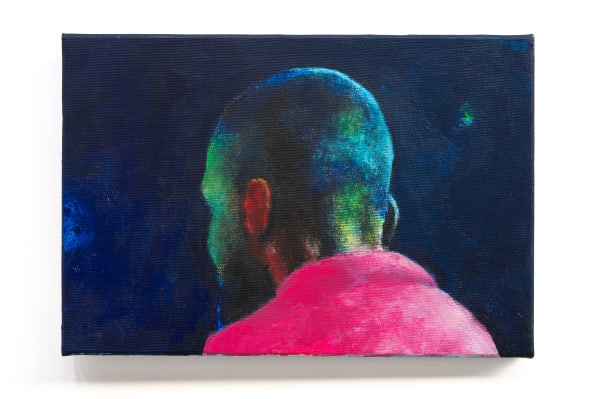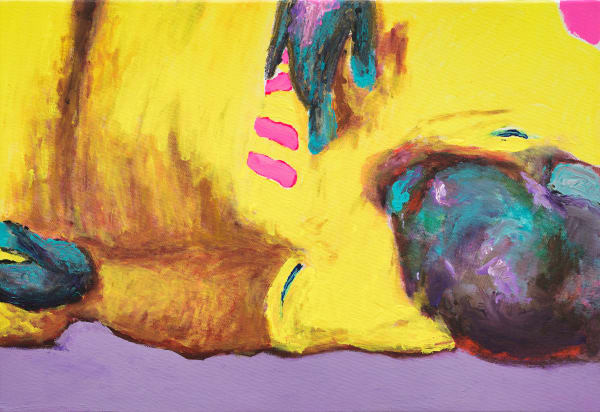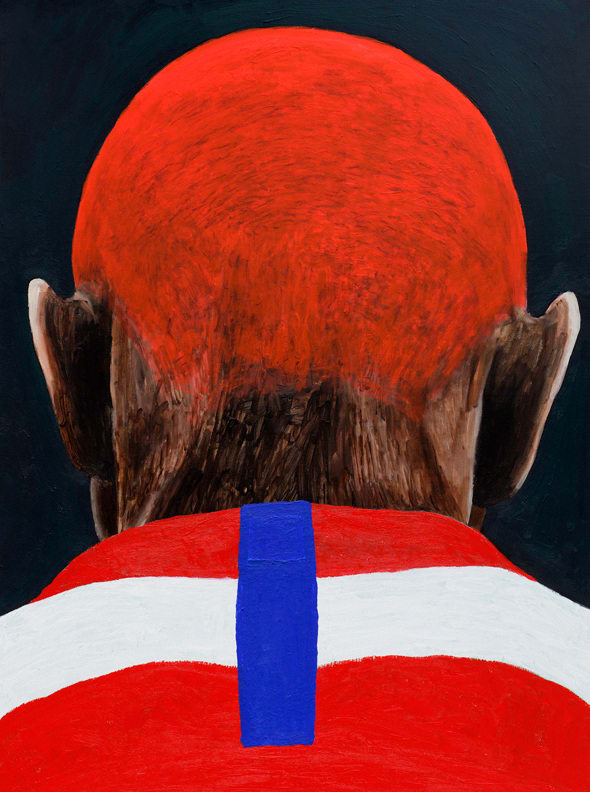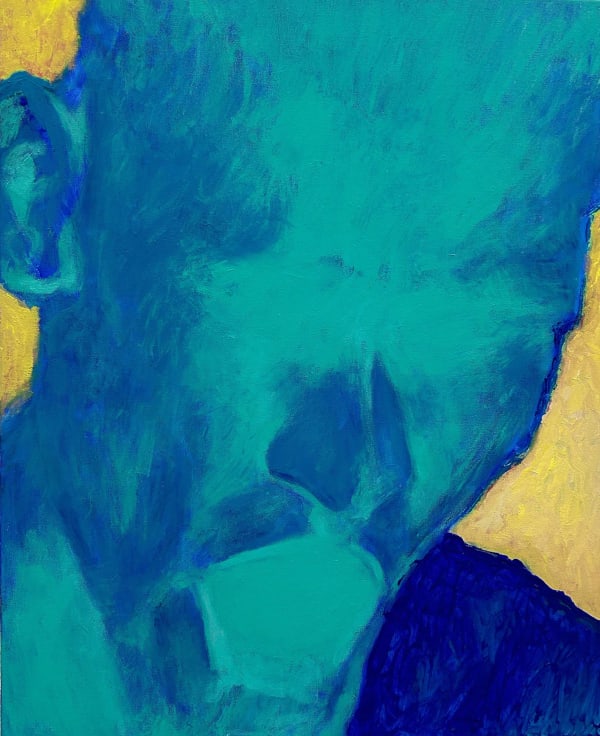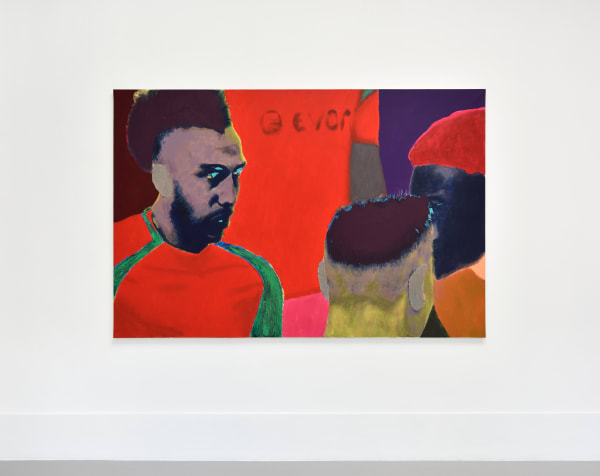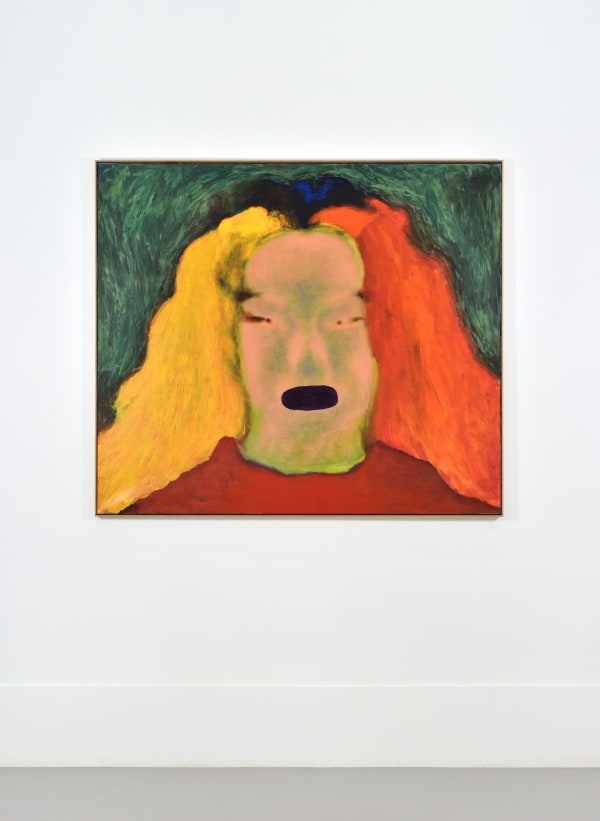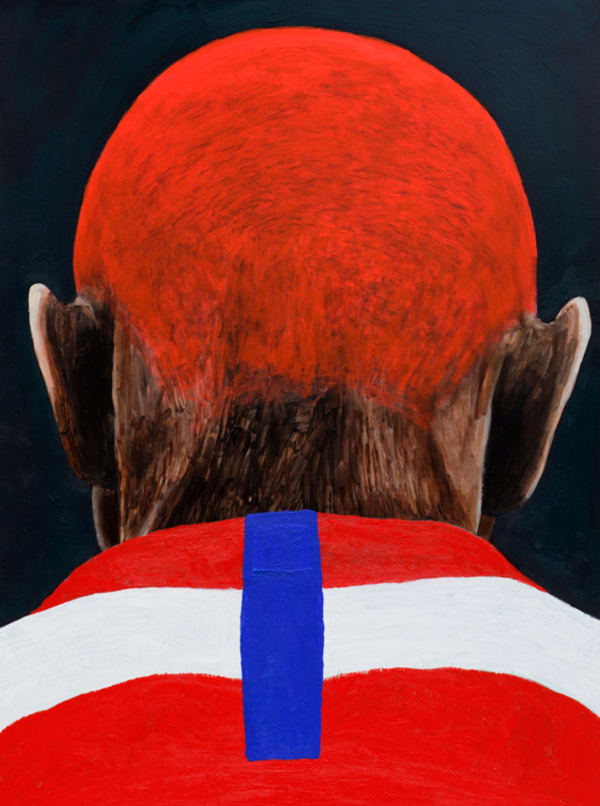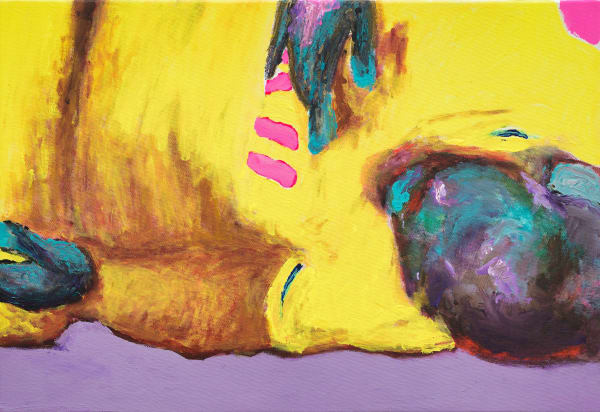No Party: Nadjib Ben Ali
Past exhibition
Press release
T H E P I L L® is thrilled to host Nadjib Ben Ali’s first solo exhibition at the gallery’s new address in Paris, 4 Place de Valois between 30 January — 1 March 2025.
Titled NO PARTY, the monographic exhibition brings together a group of recent works emblematic of the recurring themes explored by Nadjib Ben Ali, where the iridescent spectral visuality of video games, soccer matches, hip-hop videos and B-Movie slashers meet expressions of tragedy in their contemporary and art historical forms.
Nadjib Ben Ali uses his computer and smartphone screens to select, crop and Photoshop his images. Pushed to their luminous and chromatic extremes, images are meant to be withdrawn, to become impulses for painting. Nadjib Ben Ali overflows them, pulverizes them and gives them a sensitive, powerful, strident dimension, based on a universal dramaturgy that belongs as much to the games of the antique stadium as to the great Greek or Shakespearean tragedies. The soccer players are “played off”, defeated, turned into ghosts, as their spectral becoming is reflected on their faces, irradiated with fauvist colors, and on their necks, marked by the seal of fatality. The mask of the serial killer in Halloween (John Carpenter, 1978), clips by Portorican rapper Bad Bunny, French duo PNL, Spanish pop star Rosalía, the iridescent lights of screenshots of soccer matches, are all manifestations of an uninhibited practice, driven by a de-hierarchization of cultural categories and a movement of capillarity by which so-called “minor” culture rises to the level of culture described as “dominant”.
An essay by Jean-Charles Vergne accompanies the exhibition, positioning Nadjib Ben Ali’s work at the fringes of art history. It highlights influences ranging from classical masters and Fauvism to “bad painting,” while also incorporating countercultural elements from the popular domains of so-called low culture. These references converge to evoke a sense of tragic contemporary pathos: “Nadjib Ben Ali stands here, at a particular moment when so-called “low” culture infiltrates “high” culture, against the flow, like a disreputable salmon swimming upstream where it wasn’t expected. Irreconcilable subjects intermingle and infiltrate his paintings: the footballers’ necks become analogous to those of the central figure in Géricault’s Raft of the Medusa (1818), the failing bodies of athletes, collapsed or prostrated by failure, echo Manet’s Dead Man (1864) and their twilight faces sometimes evoke Léon Spilliaert’s self-portraits. The surface of the painting overplays the idea of surface, it is a “penalty area”, in the most literal and punitive sense of the word: isolating figures, sequestering facial orifices by filling them in with thick solid colors, joining motifs and bodies in a pulsating organicity that goes as far as to provoke repulsion. The paintings carry the tragedy of famous sportsmen’s faces towards their inevitable disappearance, a new celebrity driving out the previous one in a fatal mechanism of replacement and polishing. The dazed faces, in recollection or nervously tense, the bodies lying or slumped with exhaustion carry a vast iconographic history that stretches from the great founding narratives to the most current and human scenes of compunction, without however abandoning a form of absurdity — another side of contemporary tragedy. In Nadjib Ben Ali’s paintings, everything seems to be played out — in the tragic as well as theatrical sense of the word.”
Nadjib Ben Ali graduated from the École Supérieure d’Art et Design de Saint-Étienne in 2019. His recent solo exhibitions were held at The Cabin, Los Angeles (2023, U.S.) and Le POCTB, Orléans (2022, France). His work has been shown as part of institutional group shows such as Voir en peinture, MASC, Les Sables d’Olonne, Musée Estrine, Saint-Rémy de Provence and Musée des Beaux-Arts de Dole (2023, France); Glad to take height and see the slow motion world, Jeune Création, Romainville (2021, France); Novembre à Vitry, Galerie municipale Jean Collet, Vitry sur Seine (2019, France); Le jour suivant, Cité du Design, Saint-Étienne (2019, France). Nadjib Ben Ali (b. 1994) lives and works in Paris.
Installation Views
Works
-
 Nadjib Ben Ali, NO PARTY, 2024
Nadjib Ben Ali, NO PARTY, 2024 -
 Nadjib Ben Ali, Are U Ready, 2024
Nadjib Ben Ali, Are U Ready, 2024 -
 Nadjib Ben Ali, BUTYRIQUE, 2024
Nadjib Ben Ali, BUTYRIQUE, 2024 -
 Nadjib Ben Ali, HYBRID BIRTHDAY (Bluecut Mix), 2024
Nadjib Ben Ali, HYBRID BIRTHDAY (Bluecut Mix), 2024 -
 Nadjib Ben Ali, MISKINAMENTÉ part III, 2024
Nadjib Ben Ali, MISKINAMENTÉ part III, 2024 -
 Nadjib Ben Ali, O&L (Bleu nuit), 2024
Nadjib Ben Ali, O&L (Bleu nuit), 2024 -
 Nadjib Ben Ali, TOURBILLON - LA GUITARE, 2024
Nadjib Ben Ali, TOURBILLON - LA GUITARE, 2024 -
 Nadjib Ben Ali, WELCOME TO CHOUINEVILLE, 2022
Nadjib Ben Ali, WELCOME TO CHOUINEVILLE, 2022 -
 Nadjib Ben Ali, en STATUE, 2024
Nadjib Ben Ali, en STATUE, 2024 -
 Nadjib Ben Ali, CATARACTATTACK, 2024
Nadjib Ben Ali, CATARACTATTACK, 2024 -
 Nadjib Ben Ali, HYBRID BIRTHDAY (TROPICAL MIX), 2024
Nadjib Ben Ali, HYBRID BIRTHDAY (TROPICAL MIX), 2024
Exhibition Text
Nadjib Ben Ali belongs to a generation of painters whose cultural sources are drawn from the margins of the history of painting. If the masters of past centuries provide a soil, if Fauvism and bad painting infuse the surfaces, if his large-scale compositions evoke historical painting, his work is also nourished by a counter-culture (notably embodied by the American painter Ed Paschke) and references drawn from the most popular registers of a supposedly low culture. The mask of the serial killer in Halloween (John Carpenter, 1978), clips by Portorican rapper Bad Bunny, French duo PNL, Spanish pop star Rosalía, the iridescent lights of screenshots of soccer matches, are all manifestations of an uninhibited practice, driven by a de-hierarchization of cultural categories and a movement of capillarity by which so-called “minor” culture rises to the level of culture described as “major”.
Nadjib Ben Ali watches soccer matches, plays video games, feeds on rap and hip-hop clips, and is a fan of gore films and B-movie slashers. He uses his computer and smartphone screens to select, crop and Photoshop his images. All this takes place on computer or smartphone screens, which he uses to select, crop and reprocess his images. Pushed to their luminous and chromatic extremes, images are meant to be withdrawn, to become impulses for painting, not for the purpose of reproduction - a vain fascination with technological imagery - but to invert and ruin them, just as Hubert Robert ruined the picture of Le Louvre by extrapolating its decrepitude in a dystopian painting (La Grande Galerie du Louvre en ruines, 1796). After meticulously selecting and manipulating his images, Nadjib Ben Ali overflows them, pulverizes them and gives them a sensitive, powerful, strident dimension, based on a universal dramaturgy that belongs as much to the games of the antique stadium as to the great Greek or Shakespearean tragedies. The soccer players are “played off”, turned into ghosts, and their very heads sometimes have more to do with Caravaggio’s Decollation of St. John the Baptist (1608) than with any attempt at glorification or heroism. The ghostly future of the soccer players can be read on their fatally marked necks (Welcome to Chouineville, 2022), haloed by a tragedy, itself supported by the solitude emanating from their faces, which are radiant with color, even when they’re in the midst of a group. Their faces, decomposed by iridescent, acidic colors, evoke the most sepulchral of representations, where the soccer image collides with that of a horror film (Ô Dodo, 2024 or en STATUE, 2024).
Nadjib Ben Ali stands here, at a particular moment when so-called “low” culture infiltrates so-called “high” culture, against the flow, like a disreputable salmon swimming upstream where it wasn’t expected. Irreconcilable subjects intermingle and infiltrate his paintings: the Miskinamenté series uses the mask of the Halloween killer or of Jason in Friday the 13th (Sean Cunningham, 1980), while referring to its use in the video clip for 357. Python #3 or in the video for PNL’s Simba; the footballers’ necks become analogous to those of the central figure in Géricault’s Raft of the Medusa (No Party, 2024), the failing bodies of athletes, collapsed or prostrated by failure, echo Manet’s Dead Man (TOURBILLON, 2024), their twilight faces evoke Léon Spilliaert’s self-portraits (CCTVision, 2024). The surface of the painting overplays the idea of surface, it is a “penalty area”, in the most literal and punitive sense of the word: isolating figures, sequestering facial orifices by filling them in with thick solid colors (CATARACTATTACK, 2024 or Hybrid Birthday (Bluecut Mix), 2024). Occasionally, Nadjib Ben Ali uses mixtures of impure agglomerates of beige/orange/yellowish/bluish colors, coarsely brushed on and called “butter” or “margarine”, a kind of repellent binder, an unholy pictorial cartilage that joins motifs and bodies in a pulsating organicity that goes as far as to provoke repulsion.
The dazed faces, in recollection or nervously tense, the bodies lying or slumped with exhaustion carry a vast iconographic history that stretches from the great founding narratives to the most current and human scenes of compunction, interiority and existence, without however abandoning a form of absurdity - another side of contemporary tragedy - through the choice of counter-weighted titles. Such is the case with Welcome to Chouineville, a contraction of the verb “chouiner” (whine, moan) and “ville” (city) to describe the complacent lamentation of soccer players collapsed and grimacing on the ground to simulate an opponent’s foul.
Whether in figures borrowed from rap clips, monstrous faces from horror films or fallen heroic sports figures, the tragic is hidden surreptitiously in the interstices, between the boosted colors, recalling Zinedine Zidane’s confidences in the film dedicated to him by Philippe Parreno and Douglas Gordon (Zidane, a portrait of the 21st century, 2006): “Sometimes when you arrive in the stadium, you feel that everything has already been decided”. In Nadjib Ben Ali’s paintings, everything seems played out – in the tragic as well as theatrical sense of the term – and in his pictures we see “that part of theater, illusion and chance that cannot be taken away from life without mutilating it.*»
* Jean-Marie Domenach, Le Retour du tragique, Paris, Seuil, 1967, p.285
Jean-Charles Vergne
Press





